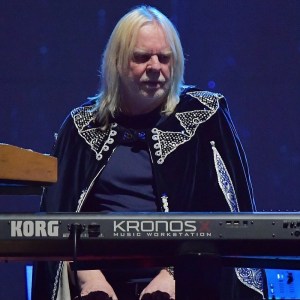Ever since breaking through with “Space Oddity” in 1969, David Bowie kept music fans on their toes with frequent reinventions of his sound and image. While Bowie didn’t lack for airplay and record sales through the early ‘80s, the one role he had yet to embody was that of the pop star. That changed in 1983 with the release of Let’s Dance. Bowie managed to pull off an album that was contemporary pop and, at the same time, unmistakably in his style. It was a hit with fans, as it was his first album to contain two Top 10 singles—the title track and “China Girl”—on the Billboard Hot 100. It was also the first to feature three Top 40 hits (“Modern Love” reached No. 14).
Videos by American Songwriter
Having scaled this mountain, Bowie was left with the challenge of figuring out what to do next. Much to the chagrin of critics and, ultimately, Bowie himself, he decided to follow up with Tonight, an album that could have been called Let’s Dance 2: Not Quite as Dancey.
So Bowie was determined to shake things up with his next album, which came nearly three years after Tonight. Never Let Me Down, released in 1987, sported a bigger sound with harder edges (due in part to the presence of Peter Frampton on guitar) than either Let’s Dance or Tonight. But Bowie soon felt remorse over the direction; Never Let Me Down ended up being the album David Bowie regretted making.
A Low Point for a Disinterested Bowie
However, critics didn’t care for the bombast or exceedingly slick production of Never Let Me Down. Fans weren’t enamored either. Three of Never Let Me Down’s tracks—”Day-In Day-Out,” “Time Will Crawl” and the title track—did achieve significant airplay. However, by peaking at No. 34 on the Billboard 200, it was Bowie’s lowest-charting album since “Heroes” reached No. 35 in 1977.
To give Bowie the benefit of the doubt, he was in a tough position when he was making Never Let Me Down. He didn’t want to repeat himself again, after he had done so with Tonight. He had already made great albums that went against the grain of the zeitgeist in earlier eras, particularly with his late ‘70s Berlin trilogy of albums (Low, “Heroes,” and Lodger). That would be a difficult feat to achieve again. However, Never Let Me Down still sounded like he was trying to make a pop album, and the ways he differentiated it from Let’s Dance and Tonight were at the margins.
[RELATED: The Meaning Behind “Heroes” by David Bowie]
A Failure for Bowie (a.k.a Most Other Artists’ Dream Release)
Over time, Bowie came to view Never Let Me Down and the subsequent Glass Spider Tour as failures. In a 1995 interview with Interview magazine’s editor in chief Ingrid Sischy, Bowie explained how he lost touch with his own artistic vision. “I tried passionately hard in the first part of the ‘80s to fit in, and I had my first overground success. I was suddenly no longer the world’s biggest cult artist in popular music.” Bowie felt pressure to be a pop star, as he thought that was what his audience wanted from him. He was making music for his fans, but not for him, and he realized “my lack of interest in my own work was really becoming transparent.”
Retrospectively, Bowie considered Never Let Me Down as his artistic low point. He went as far as to say, “I really shouldn’t have even bothered going into the studio to record it. In fact, when I play it, I wonder if I did sometimes.” Bowie was sufficiently disenchanted with one of the album’s tracks, “Too Dizzy,” that he had it removed from reissued versions.
Bowie Reinvented Himself…Yet Again
Having identified the source of his artistic malaise, Bowie decided he needed to remove himself as the focus of attention in his work. He accomplished this by forming the band Tin Machine with guitarist Reeves Gabrels, bassist Tony Fox Sales, and drummer Hunt Sales. (The latter two are the sons of the late comedian Soupy Sales.) Tin Machine’s 1989 self-titled debut didn’t represent much of a commercial comeback. It peaked at No. 29 on the Billboard 200 and failed to receive Gold certification in the U.S. Bowie did achieve his aim of creating a fresher sound—one that was better received by critics. Tin Machine was straight-ahead, lean rock-and-roll with a dissonant, noisy ambience.
Tin Machine would make just one more studio album before disbanding in 1992. Gabrels would go on to collaborate with Bowie on much of his ‘90s solo work. Bowie released nine more solo albums after the dissolution of Tin Machine, with his swan song Blackstar being released two days before his death on January 10, 2016.
Never Let Me Down Gets a Second Chance
Bowie had contemplated re-recording Never Let Me Down at several points, but he never got beyond the Mario McNulty remix of “Time Will Crawl” that appeared on his 2008 iSelect compilation. In 2018, several former Bowie collaborators, including Gabrels and McNulty, created a remixed version of Never Let Me Down that included new instrumentation. The revised version of the album was part of the Loving the Alien (1983-1988) box set.
For all of Bowie’s frank introspection over a turn in his career that didn’t go as planned, he may have been too hard on himself. The fact that he kept thinking of revisiting Never Let Me Down shows that he never completely gave up on the songs. Perhaps he would have approved of the 2018 version, with its crisper, nimbler drumming (by Sterling Campbell and Steven Wolf) and strings.
Photo by Brian Rasic/Getty Images
